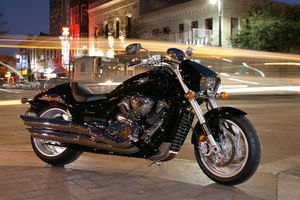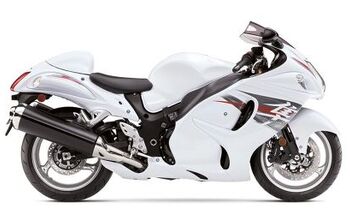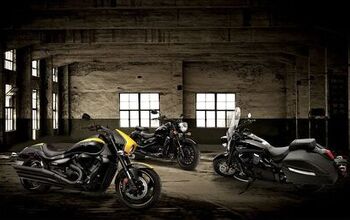2006 Suzuki Boulevard M109R - Motorcycle.com
A few years back, Suzuki did a survey to find out what their brand name meant to motorcycle enthusiasts. They learned that most people thought well of the brand, but they were best known for high performance, high quality, well engineered sport bikes, and dirt bikes. When asked about their cruiser line, the responses were more vague. In short, Suzuki didn't have a strong brand identity in the cruiser market.
Two years ago at their dealer meeting in Las Vegas, with much fanfare, Suzuki announced that they were forming the Boulevard brand for their line of cruiser motorcycles to separate their cruisers from the Suzuki name, and to promote the Boulevard line to build brand awareness and a thematic identity. From that day forward all Boulevard models would receive alpha-numeric designations with the letters C, S, and M to designate Classic, Sport, and Muscle models, and the numeric portion would designate cubic inches of displacement to replace the cubic centimeters.
When they unveiled the actual motorcycles, however, they were little more than the old line-up of cruisers with minor styling tweaks and Boulevard tank badges in place of the Suzuki badges. The assembled dealers responded with tepid enthusiasm, similar to the response of a golf audience who has just seen their favorite player bogey the 18th hole on the last day of the tournament. The powers at Suzuki, however, promised that the product pipeline was filled with new models that would be rolled out in the coming years to replace the old models, and they would be something special.
'Since Suzuki is famous for their race-winning performance sportbikes, they set out to build an all new V-twin that would incorporate all the technology they learned form their sport and race bike programs'
Last year, Boulevard brought out the M-50 cruiser, or the muscle version of the C-50 and S-50 middleweight cruisers that used to be known as the Volusia. While the motor and performance was little changed from the C-50, the M model received blacked out engine and trim, abbreviated fender treatments, an inverted fork for better handling, and looked very mean. The model helped to propel the sales of all the C-50 models so that last year they were the top selling cruiser motorcycle, not only in its displacement class, but of any metric cruiser on the market. The M-50 only served to whet the appetite of the cruiser-buying public.
This year, Suzuki made good on their promise to dealers and to customers alike, with the launch of their all-new flagship model, the Boulevard M109R. (The R refers to Suzuki's racing heritage and GSX-R line of performances bikes). It's the largest displacement cruiser that has ever rolled off the Suzuki assembly line. This bike will have dealers and buyers from coast to coast high-fiving themselves. This new power cruiser features brutish power and torque, delivered in a civilized manner, and packaged in an elegantly styled wrapper.
Since Suzuki is famous for their race-winning performance sportbikes, they set out to build an all new V-twin that would incorporate all the technology they learned form their sport and race bike programs. The engineers designed a 54-degree, liquid-cooled, DOHC, four-valves-per-cylinder V-twin displacing 109 cubic inches (1,783 cc). A semi-dry sump handles the lubrication duties. With a 112 mm bore, and a 90.5mm stroke, the piston in this engine is the largest of any gasoline powered motor, motorcycle or car, on the planet. More impressive is that big piston is pushed up and down 7300 times per minute in this high revving motor, which produces 127 hp @ 6200 RPM, and 118 pounds feet of torque at just 3200 rpm.
'As each bike fired up, we could immediately tell that this was going to be a special motorcycle.'
The M109R uses twin spark plugs, each controlled by individual ignition maps, so under light load, the twin plugs fire at the same time, and under heavy load each plug will fire at its own optimum timing to reduce unburned hydrocarbon exhaust emissions. Camshafts are high strength cast-iron alloy, just as they are on their sport models and Suzuki's unique two-stage cam chain drive system contributes to keeping the engine lightweight and compact. The cylinders are lined with Suzuki's race-proven nickel-phosphorous-silicon-carbide coating which transfers heat quicker and allows for tighter clearance for their newly designed forged aluminum pistons.
Fuel is metered out through Suzuki's Pulsed-AIR system, along with their Suzuki Dual Throttle Valve, and Suzuki Exhaust Tuning System. All combine to maximize fuel consumption efficiency, provide reliable starting in all weather, improve throttle response, and ensure smooth engine power characteristics. A powerful Electronic Control Module with a 32-bit CPU keeps everything running the way it should. Spent gasses are fed through a 2-into1-into 2 exhaust system with a large catalyzer which meets all of the E-3 emissions requirements.
While all of the technology sounds great on paper, the real test is how it works on the street. So I had the chance to travel to Austin, Texas for the World launch of the new M109R to see for myself what this new bike could do. All of the journalists were greeted at the Driskill Hotel by the head honchos from Suzuki of America, as well as the design team of Japanese engineers from the Home Office.
The first hint of the treat that was to await us came on a chilly Monday morning when 15 M109R's sat lined up on the street outside the Driskill Hotel. With each writer anxiously sitting astride their test bike, Kevin Schwantz, Suzuki's legendary 1993 World Championship Grand Prix racing star, and our guide for the day, signaled us to light up our mounts. As each bike fired up, we could immediately tell that this was going to be a special motorcycle. The aural sound of the powerful V-twin engines echoing off the concrete canyon walls was a deep, rich, basso profundo rumble.
Louder than almost any stock motorcycle I can think of, the dual slash cut pipes barked out notice that each of us was sitting atop a machine that was ready to play with any of the big power cruisers on the market. Anyone who tries to replace these pipes with something from the aftermarket should be shot. Boulevard got this right the first time. And these pipes will satisfy the needs of any stop light cowboy who insists upon goosing the throttle while waiting for the light to change.
Seconds later we lined up to rumble through downtown Austin on our way west out of town for a ride in Texas' famous "Hill Country". As we reached the on-ramp to one of the urban expressways and merged into traffic, a quick twist of the wrist opened up a can of whup-ass, as the M109R shot forward in a rush of torque and horsepower. Acceleration was strong, and immediate. Unlike most cruisers, this one features an electronic tachometer sitting just above the massive headlight fairing positioned in the riders perfect line of sight to watch the needle spin up to the 7300 rpm redline. And as the revs increased, the engine which is smooth at idle, seemed to settle into an even calmer demeanor. And in the same tachometer nacelle, all the warning lights and turn signal indicators are easy to see at a glance.
Each up-shift thwhacked into gear with an authoritative, yet well damped thump. The hydraulic clutch effort was neither too light, nor too hard. Rowing thought the gearbox to 5th was easy, and at a cruising speed of 80 MPH, a quick glance at the tach showed the 109-inch motor was only turning a lazy 4500 rpm. In fact, that was nearly the last time I used 5th gear all day. When we turned off the highway to explore the two lane rural roads for the rest of the day, the M109R seemed happiest and most enjoyable playing in 3rd gear between 50 and 80 miles per hour with the tach showing 4500 to 6000 rpm. Once, I tickled triple digits just before shifting into 4th. Since the motor ran as smoothly at six grand as it did at three, and the throttle response in third gear was so immediate, higher cogs just didn't seem necessary. Cranking the throttle in 3rd was just too much fun as the torque-monster M109R would slap you back into the wide supportive seat when pulling out to pass slower traffic, or just powering out of a turn.
From the seat of my pants, I'd be surprised if this Boulevard didn't smoke the Honda 1800VTX, the Yamaha Warrior, or the Kawasaki Vulcan 2000. Its performance most reminded me of the Triumph Rocket III, except with the more visceral and exciting pulse and throb that you can only experience with a big V-Twin.
With all that go on tap, the Boulevard paid a lot of attention to the whoa portion of the equation. Up front, twin 310mm floating discs are grabbed by Tokico radial-mounted opposed four-piston calipers, just like the ones on the '05 GSX-R1000. The reach-adjustable lever requires a light pull, with excellent progressive feel, making it easy to scrub off speed when setting up for a turn.
It's nice to know that Suzuki, and now many other manufacturers are recognizing that top flight braking components are just as welcomed on cruiser bikes as they are on sportbikes. The rear brake features a 275mm single floating disc with a Tokico pin-slide two-piston caliper. This set-up was less impressive, with vague feedback from the pedal, but it was hard to lock up even under extreme pressure.
The terrain in the Hill Country was perfectly suited to the handling characteristics of the big Boulevard. It gobbled up long sweepers like a Sumo wrestler in line at the buffet table. Just a little pressure on the perfectly placed handlebars, leaned the bike over to rail it through each turn. Despite the huge 250mm rear tire size, and unlike the fat rubber offered on the Victory Hammer, which wants to stand up through each turn unless considerable pressure is exerted constantly, the M109R felt rather neutral as it tracked through each bend in the road. Suzuki worked closely with Dunlop to design that fat D221 tire exclusively for the M109R to achieve the perfect balance between ride comfort and stability on the straights, with a computer designed profile that allows for easy turn in and stability when leaned over on challenging roads.
Like any tire that wide running on an 8.5" wide rim, on heavily crowned roads one could detect a bit of wander, but it was never disturbing or annoying.
The 46mm inverted front fork is non-adjustable, but soaked up bumps and pavement irregularities easily with 5.2" of travel. Under hard cornering, the fork could use stiffer springs, however. The rear shock is adjustable for preload, and has a fairly generous 4.66 of travel. The overall ride quality is pleasantly firm, and only a few rare occasions going over severe abrupt dips in the road would the terrain get the better of the suspension. The overall stiffness of the frame helped keep everything together as a solid feeling unit.
The 694 pounds (dry) that the M109R weighs in at means that the bike isn't flickable in tight twisties, but side to side transitions are easy to manage because the bars provide good leverage. Most of the weight is carried down low, so the bike is really well balanced, whether tipping it off the sidestand, performing the tight U-turns necessary for repeated photo runs, or at slow speed parking lot maneuvers. Cornering clearance is very generous for a cruiser, similar to the lean angles achieved by the Harley Street Rod, despite a fairly low 27.8" seat height. Speaking of the seat, the M109R has a solo seat with a stylish cowling cover that blends into the rear fender. But the bike comes with a passenger pillion pad, which can be easily fitted when that cowling is removed for comfortable two-up duty.
'Suzuki started with a clean slate in styling the M109R, and the smooth graceful lines are fresh and handsome from any angle.'
The relationship between the seat, handlebars, and foot pegs is excellent for shorter riders like me. The pegs are forward mounted, but not too much of a stretch. The wide deeply dished seat is supportive, and is all day comfortable. And while the seat narrows where it meets the tank, the big exhaust pipes on the right side forced me to splay my legs out a bit too much at stop lights. Fortunately, the pipes have thick heat shields, so that neither my leg, nor boot felt any heat. Since the M109R fit me so well, I asked one of the tallest journalists, with a 35" inseam and arms to match, how it worked for him. He praised the ergonomics as well. It's pretty amazing to have a motorcycle be comfortable to fit two people with a 10" difference in height, a 6" difference in leg length, and a 3" difference in arm length. Suffice it to say that Suzuki got it right and the M109R will be a comfortable bike for a wide range of riders.
Suzuki started with a clean slate in styling the M109R, and the smooth graceful lines are fresh and handsome from any angle. The large headlight fairing reduces wind resistance nicely, and the line sweeps up to the shapely tachometer above the handlebar clamps. A nicely fashioned analog speedometer nacelle blends into the top of the stretched gas tank, and features an LCD odometer, dual trip meters, a fuel gauge and a clock. The muscular tail section compliments the wide tire, and the abbreviated fender is graced with a jewel-like frenched-in taillight with bright LED lights illuminating the red lens. Looking down at the right side, the curved header pipes sweep out from the motor into the dual slash-cut mufflers matching the sleek flowing lines.
I usually check for frame welds, but on this bike you can't find any. The entire frame is hidden by strategically placed color matched covers up by the steering head, and below the seat, which provides this Boulevard with a well dressed, sophisticated, clean appearance. Even the brake and clutch lines are inconspicuously routed, giving the bike a much more expensive custom look than the sticker price reveals.
On the downside, the turn signals don't cancel by themselves, and I would rather have the speedometer on the top of the bars, and the tach on top of the tank. Also, I'd have liked to have seen the front fork adjustable for preload and damping. In order to save some weight, the fenders and much of the brightwork are made of plastic. While some people may view this as a negative, I'd much rather save the 50 pounds or so to have a lighter weight motorcycle. And since the quality of all the pieces is excellent, and probably a lot less costly to replace if ever damaged in an accident, I 'm all for it. And besides, nobody blinks an eye at sportbikes that use as much lightweight materials for bodywork as possible. All cruisers would benefit from making the switch from heavy steel to plastic.
The M109R comes in Black, Silver, or Violet Blue. ("Please don't call it purple", asked the PR people.) I suppose they think purple doesn't sound manly, but Violet Blue doesn't sound any more testosterone-laden as purple, and the color really is purple. And since purple adorns many Harleys and custom choppers these days, and the M109R looks great in that color, I don't think they need to worry about it.
The Boulevard M109R may be the newest kid on the block in the power cruiser segment, but it won't take a back seat to the competition. And with a sticker price of $12,399, you get a lot of musclebike for your buck. I'd look for this bike to be considered as the Motorcycle of the Year in many of the magazine awards. It's that good.
More by Ken "Hawkeye" Glassman





































Comments
Join the conversation